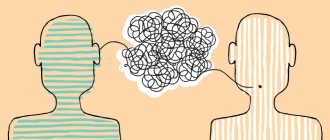personal development negotiations
16.11.2021
Author: Academy-of-capital.ru
Add a comment
Rating:
| (Votes: 1, Rating: 5) |
From this material you will learn:
- Difference between verbal and nonverbal communication
- Conscious and unconscious nonverbal communication
- The Importance of Conscious Nonverbal Communication
- 5 Functions of Nonverbal Communication
- Main types of nonverbal communication
- Features of interpretation of non-verbal signals
- Tips for developing nonverbal communication skills
There are various types of nonverbal communication: from certain gestures to touch, from a person’s gaze to his spatial position or even just appearance. And each of these signals carries certain information; it is only important to interpret it correctly.
But this does not always work out. While some gestures are quite unambiguous, others may not be entirely clear to a participant in a dialogue who does not understand body language very well. But in the case when a person is well versed in the topic, many interlocutors are like an open book to him. And this state of affairs greatly facilitates communication.
Means of nonverbal communication
The main means of such communication is the body, which is capable of transmitting information through facial expressions, gestures, pantomime, changing position in space and the mise-en-scène of communication.
Due to the diversity and richness of facial capabilities, our body is capable of transmitting a huge number of images, becoming a powerful tool for conveying the necessary information to people around us.
It’s very easy to check this: just try to watch a movie in a foreign language that you don’t speak, and you will be surprised to note that you understand, if not the very essence of the characters’ conversations, then the message, the emotions that they put into the conversation, and even main idea and plot.
This is due to the fact that, in conditions of semantic deficit arising from ignorance of the language, we subconsciously monitor facial expressions, micro-gestures more closely than usual, and read the plot and emotional components from the movements and tone of voice of the characters.
Eye contact
This method of body language allows you to demonstrate interest in the conversation and better understand the meaning of what is being said. During the conversation, both people create and then adjust their comfort level. To do this, they periodically meet each other's gaze. Then they take them aside. Staring can both build trust and create feelings of discomfort.
Eye contact maintains common themes that are pleasant to the interlocutors. Confused and negative questions lead to a person looking away, thereby demonstrating his hostility and disagreement. Those features that are characteristic of a particular eye contact allow us to draw reliable conclusions about the level of interest in the conversation and attitude towards the speaker. So, with:
- indignant, the gaze becomes intent, intrusive and a little alarming
- in admiration, eye contact is prolonged and the gaze is calm;
- the position towards the interlocutor is attentive, and eye contact is interrupted every 10 seconds;
- in anticipation, the eyebrows are raised and the gaze is sharp;
- hostility, a person rolls his eyes and avoids eye contact.
Language
Saying that we speak one language, for example, Russian, we little think about the fact that we actually know two languages: not only language as a means of verbal communication, but also body language - a universal complex of postures and movements with the help of which Representatives of different nationalities, cultures and races can communicate.
Unlike dictionary language, to master which you need to study the alphabet, phonetics, grammar and other components, sign language is unique: using obvious mental images and concepts, we can establish communication with both Amazonian Indians and Eskimos.
Of course, this communication will be simple, at the level of basic concepts, but without the use of means of non-verbal communication, through the use of words alone, we will not achieve anything at all - our language will be incomprehensible to our interlocutors, while pointing a finger at a subject of interest is universal and will help establish initial contact .
Proxemics
Proxemics is based on the construction of interpersonal relationships between individuals using spatial constraints. From the point of view of proxemics, nonverbal means of communicative communication include:
- Distance
- Orientations
- Distance
Psychologists have established several norms of “proximity” (spatial distances):
- Intimate – intended for the closest people (0-45 cm)
- Personal – allowing you to communicate with mutual friends (45-120 cm).
- Social – recommended for formal communication with unfamiliar people.
- Public – allows you to refrain from communication or speak in front of an audience.
An interlocutor who adheres to the above norms not only makes a favorable impression, but also feels more confident and comfortable.
These means of communication may vary depending on the nationality, social status and country of residence of the individual. Gender, age and personal characteristics of a person also matter.
Orientation
Such a proxemic component as orientation conveys various shades of a person’s emotional state, in terms of the angle of communication and the direction of the partner. Turning the toe and body can signal a person's attitude towards the opponent. A negotiator who decides to end the discussion involuntarily turns his body towards the exit. In business communication, seats at the negotiating table also matter:
- on the contrary, it characterizes a competitive-defensive position in which participants rigidly defend their point of view;
- on the one hand, it is the most convenient option for jointly discussing problems and developing a common solution;
- corner location - allows for a friendly and relaxed conversation;
- diagonally - the position indicates a lack of interest and reluctance of the participant in the conversation to interact.
Nonverbal signals as the only means of communication
The importance of non-verbal communication cannot be overestimated - it remains the only means of exchanging information in cases where:
- people do not know each other's language even at a basic level;
- people do not have the physical ability to make sounds.
If in the first case it is subsequently possible to establish a higher level of communication through the gradual study of each other’s languages, then in the second, various types of non-verbal communication come to the fore and become the only possible means of contact.
For people with speech disabilities and hearing loss, sign language is the only language they can use, and their fingers become their vocal cords and their gestures become their words.
In situations where people who are physically capable of producing sounds find themselves in an environment that does not allow them to pronounce these sounds, it is the tools of nonverbal communication that come to the fore. These signals are used in scuba diving (dive signals), in noisy rooms (rolling shops, engine rooms), while hunting, and when participating in hostilities (ambushes).
Interpersonal space
The distance at which the interlocutors are from each other plays an important role in establishing contact. Often people express their feelings using categories such as “I want to be closer” or “stay away from him.” People interested in each other reduce the space separating them. It could be:
- intimate - up to 0.5 m, expressing a trusting relationship between friends and loved ones;
- interpersonal (from 0.5 to 1.2 m), which is comfortable during a friendly conversation;
- social (from 1.2 to 3.7 m), characteristic of informal interaction during a business meeting;
- public - over 3.7 m - this is the distance for a person speaking in front of a group of people.
The significance and scope of such distances are directly dependent on a person’s gender and age, as well as on personal characteristics. Thus, children are always more comfortable being closer to their interlocutor, while teenagers more often close themselves off and try to distance themselves from those with whom they are conducting a dialogue. Women prefer closer distances, but self-confident and balanced people do not care about it.
The history of the emergence of nonverbal means of communication
Nonverbal behavior as a set of gestural and figurative expressions through the body arose at the dawn of humanity, when language as a means of communication had not yet been invented, and communication between individual representatives of the tribe was carried out precisely through nonverbal behavior.
It was possible to convey information through primitive gestures, and non-verbal means of communication coped with the task that ancient people needed to solve perfectly. They pointed to prey and fellow tribesmen with their hands, depicted simple phenomena - rain, thunderstorms, mimicked anger, threatened, grinning and baring their teeth.
An excellent example of primitive nonverbal behavior is the communication of dogs. Dogs almost never bark when meeting - they communicate by changing their gait, posture, level of tail movement, grinning or lowering their ears, and the information they receive is enough for them to correctly assess the situation and the status of their interlocutor.
Kinesics
Kinesics is a branch of psychology that studies human emotional reactions from the point of view of his expressive movements (body movements). In this aspect, the following are considered as the main non-verbal means of communication: posture, expressiveness of gestures, facial expressions, gait features, gaze. It is believed that the information that the interlocutor wants to convey through speech may differ significantly from the feelings he actually experiences.
Pose
The postures a person takes during a conversation indicate his true intentions, more eloquently than gestures and facial expressions. Coping with your emotions is easy, but controlling postures when communicating is more difficult.
Modern psychologists divide postures into three types:
- Dominance - a person hangs over, tries to look down from above, sits leaning back, crossing his legs. Dependency – the individual lowers his head, sits with his knees tightly clenched, fiddling with his fingers.
- Closedness - the opponent clasps his fingers, closes himself by crossing his arms and legs, moves away from the interlocutor, and looks away. Openness - an individual who is inclined to communicate is distinguished by a relaxed posture, a wide smile, open palms, outstretched legs, and the torso turned towards the interlocutor.
- Confrontation is expressed by a raised chin, clenched fists, arms outstretched or placed on the hips, sides. Harmony is manifested in the speaker’s peaceful posture and good-natured gaze.
Gestures
With the help of these non-verbal elements of communicative communication, our ancestors have been trying to achieve mutual understanding since ancient times. Head movements and hand gestures can convey the emotional state of the interlocutor - his overexcitation, sadness, joy, anger, etc.
In the non-verbal sense, sign language is classified into the following types:
- modal – conveying the attitude of the conversation participants (trust/distrust, approval/disagreement, satisfaction/dissatisfaction);
- communicative - used for prohibitions, approval, farewell, greeting, attracting attention, etc.
- descriptive - express emotional coloring in the context of certain statements.
Facial expressions
Facial reactions are considered one of the main indicators of the true feelings of the interlocutor. According to research, if an individual maintains a still face, then information about his personal characteristics is lost by 15%. Psychologists have noted more than 20,000 different nonverbal interpretations of facial expressions. The main emotional states are:
- anger;
- fear;
- irritation;
- sadness;
- astonishment;
- joy;
- disgust.
When a person’s emotional state changes, the configuration of the entire face begins to dynamically change, mainly the lips, eyebrows and forehead.
Gait
The gait personifies the individual's position in life. By analyzing a person’s style of movement, one can judge the characteristics of his character, age, well-being and even profession. By the dynamics, rhythm and amplitude of the step, psychologists learn about such states as pride, suffering, illness, anger, determination, happiness, etc. A “light” gait indicates high spirits, joy, and self-confidence. “Heavy” – typical for gloomy people who are despondent or in a state of anger. “Sluggish”, “sluggish” - happens in suffering, insecure people.
Sight
Eye contact is a non-verbal signal that is the most important element in the art of communication. A direct, interested look endears the interlocutor and arouses sympathy. Looking too long is perceived as a challenge, excessive interest of the interlocutor. A short one, on the contrary, gives reason to believe that the opponent is insincere and is hiding information. It is considered optimal to exchange glances for 10 seconds.
It is also worth taking into account the national factor, for example, Asians (Japanese, Koreans) do not often look at faces, Europeans are distinguished by their direct gaze. Depending on the specifics, psychologists distinguish the following types of views:
- social – typical for secular, relaxed communication;
- business – used in a working atmosphere (when concluding business contracts, interviews, etc.);
- intimate – personifies interest, love, etc.;
- a sideways glance may indicate hostility, envy, criticism, or suspicion.
The eyes are capable of transmitting the most subtle signals of an individual's emotional state. Constriction/dilation of the pupils occurs in a person at an unconscious level, depending on his mood and state of the body. An excited person interested in something will have pupils dilated 4 times. A gloomy, depressive state leads to constriction of the pupils.
Conscious and unconscious use of body signals
Nonverbal means of communication can be divided into two types based on the consciousness of use:
- nonverbal communication that we use consciously is those facial and gestural means that we use deliberately, that is, the tools we use to clearly convey specific information to the addressee;
- involuntary nonverbal behavior is those postures, gestures and changes in body position, as well as microgestures that we use unconsciously, uncontrollably. A specialist who knows how to read the signs of involuntary nonverbal behavior can tell more than the words we say.
Consciously used such means of communication provide a large layer of gestural, plastic and facial capabilities. Actors most clearly demonstrate this type of non-verbal communication tools: when playing a role, they use gestures and facial expressions to bring the image to perfection and give credibility to the game. The tools of good actors are very rich; they are able to remember and apply hundreds of different small poses, glances, turns of the head, which add variability to the words they use for the role.
Microexpressions and involuntary nonverbal cues
Involuntary nonverbal behavior is those contractions of the muscles of the body and face that a person is unable to control.
Consciously telling a lie, trying to hide feelings, a person is nevertheless unable to control the so-called micro-expressions flashing on the face. These are tools of non-verbal behavior that help a specialist psychologist or simply a very observant interlocutor to recognize deception, an attempt to hide information or emotions, since it is impossible to consciously keep muscles from contracting such muscles.
Representatives of certain professions, for which the ability to recognize deception is very important, are taught this ability, or they look for people who are initially predisposed to reading microexpressions. Thus, the ability to detect a lie is extremely important for customs officials, security services, and investigators.
To correctly recognize facial microexpressions, it is important to remember that facial expressions do not express the subject’s thoughts, but feelings, and if disgust flashes on the face for a moment, this does not mean that it is caused by the subject of the conversation - perhaps the person simply has an unpleasant association.
Consciously reading nonverbal cues
Like the use of nonverbal behavior, the ability to correctly read and recognize nonverbal signals given by an interlocutor can be conscious and unconscious.
Conscious reading of nonverbal behavior allows us, by observing the interlocutor, to understand by his facial expression, posture, gait, and even the turn of his shoulders, what feelings he is experiencing and what shade his speech has.
For example, the phrase: “I hate you!” written on paper cannot be read unambiguously without a description of the facial expressions of the speaker. In life, the nonverbal behavior of the speaker will say a lot about the subtext:
- if it is pronounced expressively, with frowning eyebrows, pursed lips and lowered corners, with tense fists, the interlocutor will understand the message - he is really hated, since the whole posture and face of the speaker expresses anger;
- pronounced in a cheerful tone, supported by a smile and a casual wave of the hand with a relaxed body, the same phrase becomes a playful, friendly joke.
It is at such moments that non-verbal means of communication are indispensable; it is not for nothing that authors of fiction often use the epithets “muttered”, “shouted out”, “hissed” instead of the dry “said”, giving faceless words an obvious emotional connotation.
Facial expressions
Our facial expression is the main element that reflects a person’s feelings and emotions. This is facial expressions.
We recognize any positive emotions much more easily than negative ones. Love and surprise are not as hidden by a person as anger or disgust. Researchers have proven that emotions are reflected differently on the left and right sides of the face. This is explained by the different functions assigned to the hemispheres of the brain. So, the right is responsible for the emotional sphere, and the left is responsible for intellectual functions.
In facial expressions, emotions are expressed as follows:
- a state of anger is accompanied by wide open eyes, clenched teeth, and downturned corners of the lips;
- surprise can be judged by the slightly open mouth, raised eyebrows and wide open eyes;
- when fearful, a person brings his eyebrows together and stretches his lips, lowering and pulling down their corners;
- happiness corresponds to a calm gaze, as well as drawn back, raised corners of the lips;
- a sad person can be recognized by his dull gaze, knitted eyebrows and downturned corners of his lips.
Unconscious reading of nonverbal cues
Just as the body gives away our lies by broadcasting involuntary nonverbal signals in the form of momentary microexpressions and gestures, our subconscious mind is able to read these types of nonverbal communication.
For example, you are communicating with an interlocutor who seems to be saying something pleasant, positive, making promises and convincing of his loyalty, but something inside you is itching: “He is lying, fawning, trying to hide information, he cannot be trusted!” . Some call it intuition, others call it a premonition, but from the point of view of the science of nonverbal communication, this is nothing more than the unconscious reading of the microexpressions of the interlocutor, comparing them with words and subconsciously assessing the correspondence. When a discrepancy is found between verbal and nonverbal signals, the brain tries to tell you in every available way: the person is hiding something, the gestures do not correspond to the words, you need to be on your guard!
Unconscious nonverbal behavior cannot be controlled, and specialists who can read such microexpressions learn to turn unconscious recognition of nonverbal communication gestures into conscious awareness through extensive training.
Flying gait
A beautiful gait is another non-verbal signal for men. The stronger sex is attracted by a straight back, laid back shoulders, and cat-like grace. Don't wave your arms too much - it looks awkward.
You can read a person's character by their gait. This applies not only to women, but also to men. A fearful person takes small steps. Soldier's march means a tendency to manipulate and command. Angular movements will tell about the duality in character. Such a person tries to defend himself, but may suddenly show aggression.
It’s bad when your legs move and your arms hang limply along your body. This shows helplessness and unwillingness to take the initiative. In non-verbal language it says: “I am weak, do everything for me.” Men don't like such women.
In the film “Marriage Italian Style,” Sophie demonstrated an amazing gait that became a textbook. Her husband, a director, taught her to walk beautifully. He came up with a very funny way to train. The actress had to walk between two rows of bedside tables and close their doors with her hips. Sophie practiced until the slamming of the doors was barely audible.
Basic characteristics of nonverbal signals
Various parts of the body are used as tools to use and read such signals, but posture, gait, and plasticity are also important.
The nonverbal behavior of an open, self-confident subject is characterized by the following features:
- straight back, shoulders turned, good posture, free gait;
- raised head, confident look directly at the interlocutor;
- “open” gestures - relaxed arms, not closed on the chest or in a “lock”, legs not crossed;
- absence of fussy small gestures, attempts to cover your mouth or nose with your palm.
Nonverbal means of communication that demonstrate that a person is trying to hide something:
- drooping chin, tense shoulders, slight hunching;
- a gaze constantly moving from the interlocutor’s face to the floor or running over objects behind his back;
- “closed” gestures - arms crossed on the chest, a “leg to leg” pose, involuntary touching of the nose and lips with fingers, hands “housed” at chin level.
Such signs of nonverbal communication allow you to assess the degree of frankness of the interlocutor, help you take a sober approach to what he says, and decide whether to trust the person.
Introduction to the Milton Model
Milton Erickson is a famous American psychiatrist and psychotherapist of the mid-20th century. He became the founder of a unique approach to hypnotherapy, which today is called Ericksonian hypnotherapy, and is widespread throughout the world. His model assumes that the speech and behavior of one person can influence others, putting them into a special hypnotic state called trance (see below). But before moving directly to trance, we need to talk about the unconscious mind of a person.
Unconscious Mind
The term “unconscious” itself is used in NLP to refer to processes that are not currently in consciousness. Those. the unconscious is not an object, but a process, because contains all processes that occur outside consciousness. The unconscious mind is associated with the body's basic functions and thought processes. And the conscious mind, in turn, reflects everything that is happening inside.
Even thinking itself occurs consciously in rare cases, because... The thoughts that appear in our conscious mind are the result of unconscious thinking. And we are aware of only a small part of what is in the unconscious mind. And, as a rule, this is only what has the greatest value compared to the rest.
The unconscious mind contains all of a person's thoughts, fears, concerns, dreams, expectations and hopes. All his life experience, skills and memories are there. The unconscious mind does not perceive direct communication, but indirect one: it reflects on symbols, figurative expressions, metaphors, etc., thereby expressing itself at a deeper level.
So how can a person access the unconscious mind and its resources? This is where the conversation about trance begins.
Trance
Trance is a certain state of human consciousness, the peculiarity of which is the focus of attention inward. The more a person is concentrated on his internal experiences (thoughts, sensations, etc.), the less busy he is with the outside world. And the deeper this state, the easier it is for a person to reunite with his inner world. In their everyday life, based on circumstances, people constantly switch their attention first to the internal and then to the external world, which means they sometimes enter a state of trance, then come out of it.
Based on the premises of NLP, we can name several modes of human functioning:
| 1 | Downtime – a person is focused on the inner world. |
| 2 | Uptime - a person is focused on the outside world. |
| 3 | Sleep is an extreme type of downtime, when the external world ceases to exist and only the reality of the internal remains. |
In a normal state, a person is usually somewhere between downtime and uptime. But here it is very important to know that these two states are neither good nor bad, and they can be assessed by analyzing your current activities. If you are crossing the road, swimming, holding a seminar, this is an uptime state. If you think about something, meditate, imagine something, then this is downtime. And it is undesirable to perform actions from the category of uptime in a state of downtime, for example, crossing the road in a half-asleep state, and meditating while jumping on one leg.
This leads to another conclusion that trance is a special state of downtime. And while in a trance, a person may seem completely detached from the outside world, but his personal experience at this time is extremely real for him, because a person in a trance is better aware of his unconscious processes.
Signs of trance
Trance can manifest itself through a number of physiological characteristics, the most common of which are the following:
- Muscle relaxation. A person in a state of trance practically does not move, and his movements themselves slow down and become smoother. Often such a person will be immobile for a long period of time.
- Low tone of voice. A person's voice in trance becomes lower due to the complete relaxation of the throat muscles.
- Relaxed facial muscles. Thanks to the relaxation of the facial muscles, wrinkles on the forehead and around the eyes disappear in a trance.
- Slow breathing and low pulse. Due to maximum relaxation of the body muscles, the heart rate decreases and the breathing process slows down.
- Changed eye expression. A person's gaze in a trance may become absent, because... he is immersed in his inner experiences.
- Dulling of reflexes. Normal human reflexes (blinking, swallowing) are observed much less frequently if he is in a trance. The reaction to external stimuli also decreases.
- State of tranquility. A person in trance is always in a relaxed state.
Another indicator of trance is certain physical states that are uncharacteristic for a person in a normal state:
| ✔ | Amnesia - everything that happened to a person during a trance is forgotten. |
| ✔ | Anesthesia - the sensations of discomfort and pain are dulled. |
| ✔ | Hallucination - a person can see what is not there and not see what is. |
| ✔ | Catalepsy - a person remains in the same position for a very long time without experiencing any unpleasant sensations. |
| ✔ | Regression - a person can return to his past and even adopt the behavior of a child. |
| ✔ | Curvature – spatial-temporal perception is distorted. |
Naturally, all of these states characterize a trance state, but if you are attentive to yourself, you will be able to see that quite often we are immersed in each of them in our daily lives.
Now we move directly to the Milton model.
Milton model
The Milton model is a specific set of linguistic techniques that are used to put a person into a trance or change his state in order to gain access to the resources of the unconscious mind. This is done in order to make it possible to make certain changes or resolve complex problematic situations. The Milton model was developed by the founders of NLP - John Grinder and Richard Bandler, and was based on the experiments of Milton Erickson himself.
Milton Model Standards
All language standards of the Milton model are based on the premises of the metamodel and are used to induce a state of trance and access to the unconscious:
- Deletions allow a person to learn what he wants to learn most. EXAMPLE. “In this NLP lesson you will easily learn...”
- An indefinite index of links allows a person to attach the right meaning to the right people or events. EXAMPLE. “Soon a person will come who will turn out to be an important figure in your life and will be able to teach you a lot...”
- Non-specific verbs are needed for a person to understand something exactly in the way that is most convenient for him. EXAMPLE. “You will give this your assessment...”
- Comparisons allow you to evoke the desired reactions in a person. EXAMPLE. “Every minute you relax more and more...”
- Judgments allow a person to remember specific moments in life. EXAMPLE. “It will be very good for you if you remember the brightest and most pleasant moments...”
- Distortions are needed in order for some action to become equivalent to some state. EXAMPLE. "Lean back and you'll feel better in no time..."
- Mind reading allows you to configure a person to benefit from performing any action. EXAMPLE. “The material will become much clearer to you if you just read this little chapter...”
- Nominalizations contribute to the fact that any action pushes a person into a cycle of subsequent actions. EXAMPLE. “As you study the material, you will increasingly begin to feel your awareness and ability to practice...”
- Cause-and-effect relationships allow you to configure a person to achieve a certain state through performing a specific action. EXAMPLE. “You breathe deeply, slowly inhaling and exhaling air. Gradually you relax and your thoughts come into order...”
- Assumptions set a person up to perform a specific action. EXAMPLE. “I don’t know if you will remain the same after reading this book...”
- Versatility allows you to remove conscious blockages. EXAMPLE. “The solution to this problem is already known to you, because... your subconscious knows it..."
- Modal operators of possibility increase a person's confidence in himself and his abilities. EXAMPLE. "You can do that! I'm sure you will succeed..."
- Modal operators of necessity allow you to motivate a person to action. EXAMPLE. “You just have to try it! If you want to understand the meaning, you need..."
And now we will talk about how to apply the Milton model in practice, because in order to learn how to use the acquired knowledge, we must master a certain structure of actions. We will look at it below.
Application of the Milton Model
Application of the Milton model involves the following three phases:
- Following a person's experience and putting him in a trance state
- Eliminating the Conscious Mind
- Accessing the Resources of the Unconscious Mind
Let's talk about them separately.
1
Following a person's experience and putting him in a trance state
The simplest way to follow is to describe to a person the experience that he receives through hearing, seeing or feeling something. During communication, you need to describe some process, without focusing on details, but giving the person the opportunity to switch to his inner world, thereby transferring him into a state of trance, because the person is immersed in himself. In this case, you need to speak not loudly, calmly, so that the person does not feel discomfort. EXAMPLE: “Imagine how good it would be if we...”
2
Eliminating the Conscious Mind
This stage is based on several standards that direct a person’s attention inward:
- Phonetic ambiguity is the use of words that sound the same but have different meanings. EXAMPLE: “Rise”, “Edge”, “Sign”, etc.
- Syntactic ambiguity is the use of words that do not clarify the meaning of the context. These are mainly adjectives and participles. EXAMPLE: “Conditioned attribute” (conditioned by you or conditioning something?), “Passionate person” (fascinated by you or carried away by himself?), “Lost material” (lost by you or lost in general?).
- Ambiguity of scope - the use of sentences or phrases in which the exact subject of the conversation cannot be understood. EXAMPLE: “Elderly women and men” (who exactly is elderly?), “Execution cannot be pardoned” (what exactly should be done?), “It would be good to do this” (who would be good or good if done? Who should do it?).
- Punctuation uncertainty is the combination of individual sentences into one complex one, from which it is impossible to understand what is being said. EXAMPLE: “We think the new material has a strong effect on you because... your day is already going differently.”
- Double binds are the use of sentences that imply a choice without a choice. EXAMPLE: “You can apply new knowledge now or later, or you can not apply it at all,” etc.
As additional techniques in the Milton model in order to tune a person into a trance state, you can use any basics of the metamodel, because when used skillfully, they stimulate his attention to immersion in himself.
3
Accessing the Resources of the Unconscious Mind
The techniques of the Milton model suggest the possibility of gaining access to the unconscious without causing a person any fears or assumptions in this regard:
- Conversational postulates - the use of questions that require monosyllabic answers, but serve as a command. EXAMPLE: “Could you imagine that...?”, “Did you know that you can read minds?” and so on.
- Tag questions are special questions that are inserted at the end of the main sentence in order to motivate a person to agree with you. Using several of these questions in a row sets the person up to agree with you altogether. EXAMPLE: “It’s easy, right?”, “You can do it yourself, right?”, “It’s convenient, isn’t it?” and so on.
- Embedded questions are indirect questions that are inserted during communication, but the interlocutor reacts as if they were asked directly. EXAMPLE: “How can I find out what exactly annoys you?”, “Could you help me by explaining a little the essence of your problem?” and so on.
- Embedded orders are indirect instructions for action inserted into a conversation during communication. EXAMPLE: “It is unknown whether you will be able to apply new knowledge in practice today,” “People with similar problems are always determined,” etc.
- Quotations are used to emphasize information obtained from third-party sources, without making any guarantees. EXAMPLE: “An acquaintance told me that NLP is very effective in communication,” “My friend said that meditation helps you relax,” etc.
- Metaphors - parables, analogies, figurative expressions are one of the best ways to access the resources of the unconscious mind. EXAMPLE: “Believe me, your potential can unfold like a lotus flower,” “Just pay attention and see how the days fly by,” etc.
In addition, it should be recalled that the foundations of the Milton Model we have discussed are not exhaustive and represent only an introduction to this topic. If you have a desire to get acquainted with it in more detail, you can turn to this interesting book.
And in conclusion of the article, I would like to say that nonverbal features in people’s communication can sometimes say much more about a person than the most informative communication, and the skills of recognizing and applying them can provide a significantly better result than any other psychological approach. It is only important to practice and do it systematically, because, as far as we know, only regular training brings the desired results.
Business conversation
Nonverbal means of communication in negotiations and at work are of great importance: despite the formal unspoken ban on an overly expressed emotional component in business communication, a successful salesperson is able to either fail a product presentation or save it with the help of properly constructed nonverbal communication with listeners.
If a specialist presenting a product or technology presents it, monotonously reciting the text, without using a change in intonation, without supplementing the words with gestures, facial expressions, if he slouches and nervously rubs his hands, the listeners unconsciously read all these signs of uncertainty and are imbued with distrust of the product through distrust of the person presenting it to a person.
If the presentation is accompanied by competently delivered speech, rich in intonation, supported by open gestures, a smile, good posture and an open look, unconscious non-verbal communication signals: your interlocutor is worthy of trust, which means the product is too.
Nonverbal cues in face-to-face communication
Nonverbal communication in personal relationships is the basis of communication. Words alone, without emotional reinforcement, without touches and small, but unconsciously read signals, will not get you far in family life.
Spouses may communicate little, exhausted by everyday life, children and work, but if in a dream they move closer to each other, if in rare hours of being together in the house, even when each is busy with his own business, they find a second to touch each other, smile - such the family is strong.
On the contrary, couples who publicly hug, kiss and otherwise express positive emotions at the level of conscious non-verbal signals, but do not experience warm feelings for each other, betray themselves by the absence of small gestures - momentary touches, glances, light smiles, and others often unconsciously read this information and before the spouses themselves begin to guess that something is wrong in the family.
To maintain relationships, it is very important to remember about non-verbal means of communication, not to underestimate the importance of touch and expressing emotions not only through words.
Virginia Satyr Categories
Virginia Satir was one of the world's leading psychologists and family therapists. And the basics of its work were used at the very beginning of the development of NLP. During her career, she wrote many works in these areas and also gave lectures. During her practice, she noticed that all people, as a rule, fall into one of five categories of linguistic behavior.
These types are: blaming, ingratiating, calculating, detached and balanced. They all reflect basic communication styles and provide a significant amount of data about how a person prefers to interact with others. Let's look at these categories in more detail:
| 1 | Accuser. People belonging to this category tend to look for people who can be blamed for the fact that everything is not happening as it should. They project their experiences onto others, call them different names, point fingers at them, and use stern gestures. Their main motivation is to show others their “place” and to reprimand. Blaming people are usually very lonely. |
| 2 | Ingratiating. The peculiarity of ingratiating people is that they mirror those who accuse, also wanting to shift the blame onto someone else. But they do it a little differently: despite the fact that they shift responsibility to others, they make an effort to ensure that they themselves are perceived as very pleasant and positive people. Moreover, they may even take the blame for something in order to whitewash themselves. Ingratiating people often point out cause-and-effect relationships, use a lot of nonspecific verbs (that don't say anything specific about how something was done) and modal operators (can, can't, must, must, etc.), but don't use sharp gestures. |
| 3 | Calculating. People of this type prefer to hide their emotions so as not to reveal their true reactions or intentions. They are rational, unemotional, and have self-control. Those around them often perceive them as indifferent, aloof, cold, and insensitive. They relieve themselves of responsibility by moving the conversation into a more general direction and using “you” messages, i.e. phrases that make others feel guilty. Due to their personality traits, such people often live alone. |
| 4 |
How to learn to correctly recognize nonverbal signals
By learning to correctly interpret other people's nonverbal signals, you can expand your capabilities, raise nonverbal communication with your interlocutors to a new level, and also learn to recognize attempts to manipulate you.
In order to improve non-verbal communication skills, try to absorb when communicating, notice not only some noticeable, “large” gestures, but also note small ones, perceive the entire palette of human motor skills: facial expression, posture, posture, finger movements and gaze, shift intonation. This will allow over time to cut off superficial, conscious gestures of the interlocutor, identifying micro-expressions and noting signs of deception or unconscious lies. By noticing the broad gesture of your hands, you will also learn to notice the rapid licking of lips that betrays excitement, and then non-verbal communication with people will turn into an exciting ride in which attempts to manipulate you will be broken by your ability to recognize them and avoid them.
Recognize deception
Is it possible to feel comfortable and confident when communicating with different people? Yes, but this requires knowledge of non-verbal communication. This will allow you to avoid situations where the interlocutor is trying to deceive.
The correspondence between the verbal and nonverbal signals given is called congruence. In this case, we can say that the interlocutor is telling the truth. They will tell you about the falsity of the information provided:
- too frequent or long pauses, as well as hesitation before each remark;
- lack of synchronicity in the work of facial muscles, asymmetry of facial expressions;
- a frozen expression on the face that remains unchanged for 5-10 seconds;
- the occurrence of pauses between the word and the emotions related to it;
- a forced smile;
- shallow eye contact, with a restless facial expression;
- twitching of any part of the body, biting lips, tapping on the table with fingers;
- few gestures under the control of the liar;
- heavy breathing and high pitched voice;
- crossed legs and bent body;
- blinking eyes at a high frequency.
Nonverbal communication and errors
Non-verbal communication is an important component of human communication, and the ability to understand signals helps a lot in life, but we should not forget that excessive enthusiasm for the theory of micro-expressions and unconscious gestures can fail if we do not remember the possibility of mistakes. You should always remember the conditions in which the dialogue is being conducted: in a stuffy room with dry air, for example, licking your lips can symbolize not so much an attempt to deceive as to moisturize dry skin, and folded hands on your chest are sometimes intended not to close yourself off from your interlocutor, but to cover up a poorly placed stain on clothes.
Nonverbal communication is a huge layer of information that you need to be able to use in order to improve your communication skills and learn to avoid outside manipulation.
Recommendations for men
If you smile too often, you may be perceived suspiciously, therefore, as for the opposite sex, it is important to be able to laugh sincerely. If you remember, the psychology of the weaker sex is such that they easily read non-verbal information; this skill is inherent in nature so that the mother can recognize the needs of her baby
Therefore, the most basic recommendation is to be sincere. When communicating, show as many open gestures as possible, which indicate a willingness to be honest and open. For example, do not hide your palms, do not cross your legs... Do not focus your attention on other girls, otherwise the interlocutor will catch your gaze, which will not have a positive effect on the relationship . There is a gesture that indicates your self-confidence and inner strength, it is called the “pyramid”, this is when the fingertips and palms are joined together. So, if you want to conquer your interlocutor and not give away your excitement, use it during meetings. To make you more inclined to have an intimate relationship, you can use this technique: place your index finger on your lower lip, hold it for a couple of seconds, then lightly tap the lip a couple of times and remove it. This will reinforce the message and desire to move to a new level in the girl’s subconscious. Listen carefully, try not to interrupt, lean your body forward slightly to demonstrate your interest. You can put your thumbs behind the belt, and if you are sitting, keep your hands on your hips, or stretch your legs forward, this will create a feeling of your disposition towards the girl, as well as a manifestation of love and a demonstration of masculinity.










